Diese Seite ist derzeit leider nur auf Englisch verfügbar.
Recording the physical features of Codex Sinaiticus
Before the Codex Sinaiticus could be digitised a thorough analysis of its current condition was carried out by Conservators in all four
locations, in order to identify damages and areas in need of stabilization.
Together with the condition assessment it was felt important to carry out a survey to record all possible information in regard to the making
process and the physical characteristics of this incredible manuscript.
A documentation form which recorded material and codicological features, as well as the condition of the manuscript, was developed by
Conservators at the BL, in consultation with all the parties involved.
To identify the areas where the features were observed, conservators divided a folio into key text and margin areas. These divisions were drawn
on a sheet of polyester, creating a grid contained within the outline of a standard CS folium. Each location in the grid
was given a letter: a, b, c & d identified the text columns and e, f, g, h, i and j identified the margin areas.
If a feature was observed in specific lines of the text columns, the letters a,b,c,d were also accompanied by the appropriate line number: for
example an entry a12 + b10 under the category of Ink Offset means there is evidence of ink offset in text column a at line 12 and in text
column b at line 10.
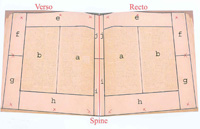 |
 |
| 2 Column Grid |
2 Column Grid |
The form includes 8 different sections:
These sections were subdivided by documentation categories designed to help to illustrate as close as possible the steps of the making process
of Codex Sinaiticus.
Codex Sinaiticus represents the cutting edge of book-making of its time. This section collects information about where each page of Codex
Sinaiticus features within the overall structure of the book.
A codex is a book made up from sections or groups of folios that are sewn together.
Codex Sinaiticus originally comprised at least 94 quires, which are the individual sections, usually made of 4 sheets
folded in half.
A sheet folded in half is called bifolium (plural is bifolia) from a Latin word meaning 2 folios (folia) or 2 sheets.
Each quire is therefore made of 4 bifolia, or 8 folia or 16 pages, the ‘page’ being defined as one side of a folium. The front page of each
folium is called recto, the back is called verso.
In the physical description, a leaf within a quire is allocated a number between 1 and 8 to indicate the position of the folium within its
quire.
In the making process of a book, the quires are first formed, then prepared for writing and finally filled with the text.
Once all the quires are hand written they are assembled together to be sewn.
In order to make sure that the sections are kept in the right sequence, they are numbered or marked in some unequivocal way. This number is
called quire number, and in the Codex Sinaiticus it’s written in Greek numerals. Scholars and Conservators in
different times found that the fasciculation number was repeated in each quire: one number appears on the top edge, left side of the first
folium of the section, but is not always visible; the other one appears in the same folium, but on the top right corner, it is always visible,
and it is written with an apparently different ink from the previously described one.
Each of the holding institutions numbered (foliated) their parts of Codex Sinaiticus differently. For example both the British Library and
Leipzig holdings are numbered consecutively starting from 1. In both cases this number has been written with pencil but the BL holdings are
annotated at the upper right corner of the recto side whilst the Leipzig holdings are annotated at the bottom right corner of the recto
side.
Codex Sinaiticus was written on prepared animal skin, called parchment. Parchment is very often made from calf, goat or sheep’s skin and has
been widely used as a writing support.
The making process of lime soaking, de-hairing, stretching and scraping skins has remained essentially the same for over two millennia.
Being animal skin, parchment has a 'flesh' (facing the inner body of the animal) and a 'hair' (from which the hair grew) side. The 'flesh' side
tends to be lighter in colour and smoother in appearance whilst the 'hair' side tends to be darker, less smooth and in some cases easily
identifiable by remains of the actual hair follicles.
Skin characteristics such as follicle patterns, skeletal marks, scar tissue and variance of colour can tell us much about the type of animal
and its condition. Other man-made characteristics like makers’ holes and repairs, striation, uniformity of thinness, and veining evidence tell
us much about the quality of process and skill of workmanship
All these features have been recorded on the documentation form.
Follicle patterns vary according to the animal of origin and can be used to identify the type of animal. The location
and amount of follicle marks can also be indicative of the size of the beast, where on the skin the parchment was cut from, and the quality of
the workmanship.
Follicles are often visible on the axilla area, which is the loosely structured and stretchy area of the animal skin
behind the forelegs and in front of the hind legs. Such areas are also characterized by a more widely spaced hair follicle network. Axilla
evidence can indicate the size of the animal which in turn informs the identification process. In prepared skins this will tend to appear at
the outer edges and more rippled than the rest of the skin. Due to the way the skin is folded to form bifolia, axilla is frequently found at
the edges of the leaves.
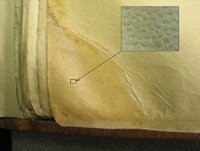 |
 |
| Follicle marks |
Axilla |
Other characteristic marks, some times found along the outer edges of the folia, are caused by proximity to the animal's skeleton and,
particularly, from the highpoints of the pelvic, spine and shoulder areas. They often appear as dark patches clearly visible in transmitted
light. On the documentation form the Conservators referred to these evidences as ‘skeletal marks’ and recorded the
area where they were visible.
Injuries sustained by animals whilst alive are often still visible on the parchment produced from their skins. They appear as a thinner tissue
(scar tissue) which grows over to heal an injury. The amount of scarring evident can indicate the quality of
life the beast may have had as well as informing the observer about the quality of parchment selection
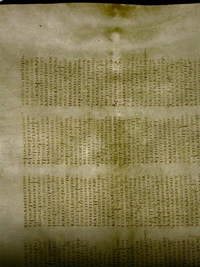 |
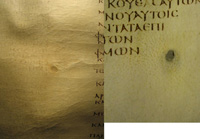 |
| Skeletal marks |
Scar tissue |
Parchment can sometimes still show evidence of the vein network which will appear of a light colour if the animal has been bled thoroughly or
dark if this process has been poorly done.
Conservators called the visible vein network ‘veining’.
The occasional jagging action of the knives when thinning down the skin could also sometimes leave parallel marks on the parchment. This type
of damage is called striation.
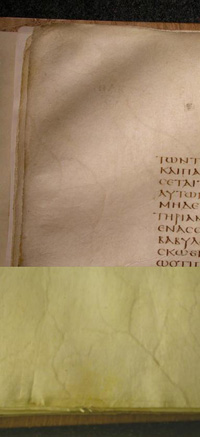 |
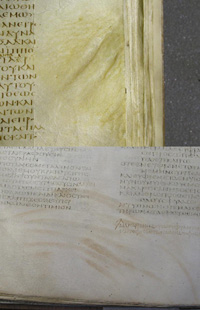 |
| Veining |
Striation |
The knives used by parchment makers to de-hair and scrape the stretched skin could leave marks on the parchment. Any minor damage to the skin
could end up as a hole after stretching, unless these holes were repaired. The conservators recorded the location of such un-repaired parchment maker's holes as well as of the parchment maker’s repairs.
 |
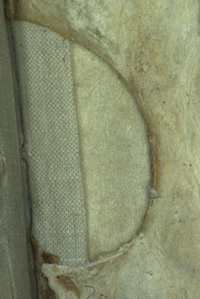 |
| Parchment maker's hole |
Parchment maker’s repair |
Information about physical characteristics such as the thickness of the parchment, the opacity, the colour or the surface appearance, were
recorded on the documentation form and measured according to the IDAP (Improved Damage Assessment of Parchment)
standards.
The thickness of the parchment was an important characteristic when considering comparisons across all holding sites.
Significant changes in thickness may inform the history of conditions the Codex has existed in. In order to record the average thickness of
each parchment leaf, seven measurements from different parts of each leaf were taken with a measuring instrument (caliper).
The opacity is the ability of material to obstruct light rays as they pass through it. Significant changes to this
ability over time can indicate changes in the condition of the material.
Important information can also potentially come from a variation in the colour or in the surface appearance (Matte – Semi Matte - Glossy) in the support.
The process of making a book in antiquity was quite long and complex.
Generally this would start with the choice of the type, amount and quality of the writing support. The text to copy had to be distributed
between the scribes as well as the quantity of the materials needed.
The support had to be prepared for writing: the parchment, for example, was abraded where the script was going to be and lines drawn for the
scribe to follow. Sometimes the quires would have been assembled and temporarily secured together before the text was copied.
The sections were then sewn together, the boards connected to the text block, and the cover applied.
The category ‘Scribal’ groups all those features caused by the preparation of the parchment for writing (pricking and ruling) and scribal
features of interest beyond the ones characterizing the base text, like annotations and variance in the texture of the parchment and ink
colour.
This section also includes precise measurements of the dimensions of each folio: the longest and shortest
height dimension and the widest and narrowest width dimension.
In order to be more accurate and for the process to be safe, all the measurements have been taken from the outline of the folia traced with a
pencil onto a Polyester sheet.
The Polyester sheet is flexible and allows for distortion by following the undulation and deformation of the parchment leaves.
In order to create a surface on which the ink would adhere well, often the parchment was rubbed with a rough flat object (e.g. pumice stone) by
the scribe or an auxiliary person. The different types of textures (abrasion or pouncing) of the
parchment are determined by the way the surface of the support is rubbed.
The next steps in the preparation of the vellum were the pricking and the ruling.
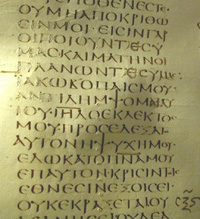 |
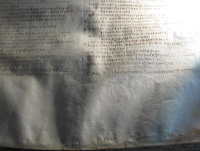 |
| Pricking line |
Ruling |
The person responsible for this process used a pointed tool to make small holes which marked out the position of bounding lines and text lines,
these are called pricking marks and their presence, sequence, location and distance can provide important
information on how and by whom (whether the scribe or somebody else) the support has been prepared prior writing.
The pricking marks were used as a reference to score straight and parallel lines with a blunter instrument. The vertical lines (bounding lines) traced the column borders while the parallel horizontal scores set the text
lines.
In Codex Sinaiticus the distance between the text lines pricking marks is either single (S), double
(D) or quadruple (Q) spaced, depending on whether the pricks appear every text line, every second text line or every
four text lines. The same system has been used to record the distance between the ruled lines.
The direction of these 'pricking marks' (the direction from which the marks were made) has also been recorded by examining the indent and burst
from the pricking instrument when looking at the recto side of the leaf. The following symbols help to illustrate the data recorded: ‘?’ for
upwards, ‘?’ for downwards. These same symbols have also been used to record the ‘ruling indent’ which is
determined by looking at the recto of the leaf and identifying the side the folium had been ruled from: ‘?’ for 'from above' and '?' for 'from
below'.
The position of the ruling to the pricking marks can also give further information about specific
habits of the scribe or of the person in charge for these processes. Conservators used ‘A’ to indicate when the ruling lines are above the
pricking marks, 'O' when they are on the pricking marks and 'B' when they are below the pricking marks. The same code has been used to
indicate the position of the text in relation to the ruling: 'A' indicates that the text was written above
the ruled lines; 'B' indicates that the text was written below the ruled lines; 'O' indicates that the text was written on the ruled lines.
Combinations of letters (A, O; A, O, B; etc..) can appear at the same time when there is an inconsistency across the folium.
Sometimes, additional lines to those used for delimiting the text and the columns were detected, including feint ruled lines from the ruling of
the adjacent leaf (secondary ruling). They too have been described and the location and direction of scoring of
the lines specified.
Other features observed are annotations/corrections, their ink colour and position in the page. Three main categories group some of all the
different para-textual elements: ‘spine margin annotations’, ‘other
marginal annotations’ and ‘feint or small annotations’. This group of data is of particular
significance for the digitisation and for possible future scientific analysis.
The variances in the colour of the ink used on the same page for the text, for the interlinear writing
or for the corrections/annotations could be an indication of different scribes or correctors. Significant examples were flagged for further
ink analysis.
A ‘substitution’ is a part of the text that has been erased by a scribe or a corrector and substitute with another
text.
Fresh ink applied by the scribe directly upon faded or flaked text without erasing or washing it out intentionally, has been called ‘overwriting’ in the documentation form and it is normally indicated by a visible change in the density and colour
of the ink.
When these phenomena were marked by a clear difference in ink colour, conservators recorded the location.
The inner side of the central bifolium of each quire of Codex Sinaiticus appear to be marked with ink. This mark, possibly used as an assembly
or collation mark from a re-binding has been called by the BL Conservators ‘squiggle’.
Codicology is the study of books as physical objects. It researches how books were made and put together. This category groups all the
remaining features not explored in the other sections, which might help in understanding how Codex Sinaiticus was made into a physical
book.
Many of the existing repairs carried out by Douglas Cockerell on the Codex Sinaiticus were made in the 1930s.
Unfortunately these hid many elements which could reveal information about the previous sewing and the binding structure the book. The
existing images and condition report describing the Codex when still unbound do not give a clear picture of some important codicological
aspects such as the number, shape and distance between the sewing stations.
However, there are still some visible features that can be observed, recorded and possibly interpreted.
For example, slits along the spine margin can be explained by vellum thong
overcasting / repair. This type of lacing is still intact on the leaves at St Catherine's, but evidence of such
slits is mostly hidden by the more modern Cockerell repairs. Thus, any evidence of slits on other leaves may help to determine when &
why this repair was applied.
Overcasting as well as overcasting holes running in line along the spine fold area may
also be an indication of an old repair. Overcasting is a process in which two or more leaves (singletons or bifolia) are joined together by
sewing them along the spine through the inner margin and around the spine-fold, using over-sewing. This is usually indicated by a continuous
run of punctures along the spine margin. The conservators also recorded the directions ('?' or '?') of the punctures observed.
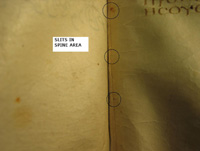 |
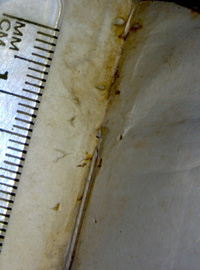 |
| Slit along the spine margin |
Overcasting hole |
Any holes in the spine margin area, whether individual or a series, other than apparent overcasting can also be
an indication of previous treatments in the history of Codex Sinaiticus.
Consideration of the aggregate evidence may determine the number and style of previous binding structures and any changes in quire
sequence.
A sewing station is where the needle enters or exits from the fold of a quire to anchor the quire around a support or to previously sewn
quires. In each sewing station it is expected to find a hole. The number and location of obvious sewing station
holes were recorded.
The foredge markers are often placed to mark the beginning of a new chapter or a relevant section in the text. They
can be made of many different materials and anchored to the support in many different ways. In Codex Sinaiticus the conservators found two
types of foredge marker: one made of thread sewn through the support and then knotted; the other, made of leather (leather tab) glued on and folded around the parchment support.
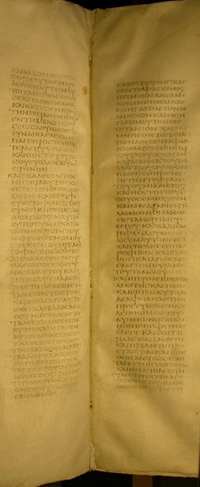 |
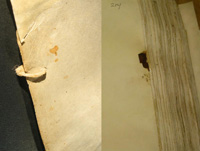 |
| Sewing stations |
Foredge markers |
Part of the meticulous assessment of the Codex Sinaiticus involved the recording of evidence from previous conservation treatments. This
section groups any features that could be from a previous treatment.
Douglas Cockerell repaired and bound the Codex Sinaiticus leaves held at the British Library for the British Museum in the 1930s. The location
of any evidence from a repair made before Cockerell's work was recorded (pre-Cockerell repair).
In a similar way, the Conservators took note of the number and the type of repairs performed by Douglas Cockerell, distinguishing between parchment repairs, applied along the edges, silk gauze repairs applied within the
text, and linen guards used to join back together or to reinforce bifolia at the gutter. A linenGuard guard is a strip of
linen cloth folded in the centre and pasted to the support.
Singletons, single loose leaves, are often anchored to the adjacent quire or bifolia through a small extension of the parchment support folded
around the quire to form a hook. This extension is called hook guard.
Cockerell devised a specific structure for the Codex Sinaiticus that would allow a full and easy opening of the book without applying any
adhesive on the spine fold of the outer bifolium of each quire. The sections are sewn to a stub guard, which is a
folded piece of material (in this case parchment and paper). The stub guards are then sewn all together and form the text block. The
assessment recorded the number of sewing holes used to anchor, by means of a sewing thread, the sections of Codex Sinaiticus to the stub
guards (stub guard sewing holes).
The small stitches at head and tail of these stub guards are called tacketing and their presence has been noted down (stub guard tacketing).
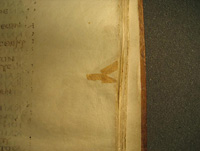 |
 |
| Pre-Cockerell repair |
Parchment repair by Cockerell |
Codex Sinaiticus is made of organic materials which will break down over time in detrimental environments.
As part of the meticulous physical description, the conservation team made detailed assessment of the condition of the Codex. The location and
some time the extent and the severity of each of the damages examined have been recorded.
Surface dirt/dust was defined as any dirty marks which could be easily removed if necessary.
Ingrained dirt was defined as dirty marks which are ingrained and whose removal would cause
damage to the surface of the parchment.
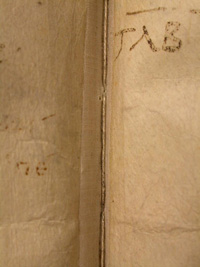 |
 |
| Surface dirt |
Ingrained dirt |
Handling marks were defined as grubby areas and finger marks around the margins of the leaf, particularly the
corners and foredge.
Staining was defined as a discoloration of the support caused by an external agent rather than the degradation of the
support itself.
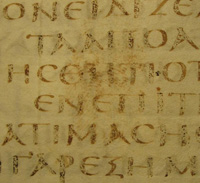 |
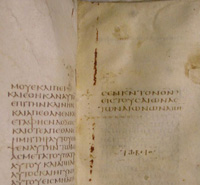 |
| Handling mark |
Staining |
Accretion is a built-up deposit of dirt or other substance on the parchment. On the documentation form the nature of
the accretion has been in most cases specified using 'W' for wax, 'I' for insect, 'G' for glue and 'O' for other.
Curling refers to the natural movement of parchment in one plane without restricting leaf flexibility. Conservators
recorded where curling occurred.
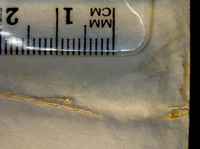 |
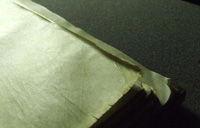 |
| Accretion |
Curling |
Creases are permanent lines showing peaks and, perhaps, slight surface breakage. They are also defined as areas where a
simple crease would lie flat if put under a glass weight.
A crease line is a crease still visible on the parchment but now locally flat.
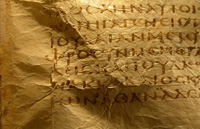 |
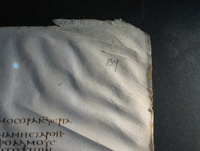 |
| Crease |
Crease line |
Folds in the support have also been recorded.
A pleat is a double fold, where the parchment has been folded back onto its self. The full view of the leaf is, therefore,
restricted.
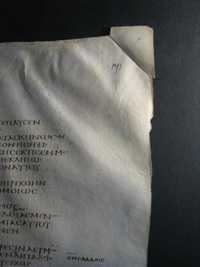 |
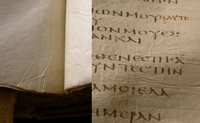 |
| Fold |
Pleat |
Cockling, classifiable as major or minor, is the contraction of the parchment that causes wrinkles or puckering at the
edges of the leaf. The parchment is distorted to the extent that it would not lie flat under a light-weight glass without folding or pleating.
 |
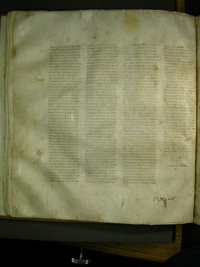 |
| Major cockling |
Minor cockling |
Creasing, cockling and similar parchment features can cause distortions of the surface of the leaf. The
location of distortions greater than 5mm was recorded when these occurred on areas were text had been written.
Contraction can happen to the spine, causing lateral movement in the parchment leaf, or just local deformation of a small area of the leaf
caused by, for example, a liquid drop.
 |
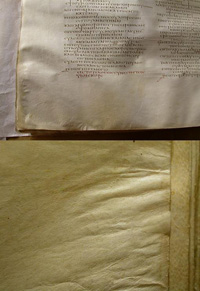 |
| Contraction - spine |
Contraction - local |
A tear extends from the edge of the leaf with no or minimal loss. A main characteristic of a parchment tear is that the
edges have projecting fibers pulled from the apposing edge.
Splits are tears that have both ends contained within the parchment leaf. They can sometimes evolve from ruling lines
scored on a thin parchment.
 |
 |
| Tear |
Split |
Losses in the support where classified as internal, when they were in the central area of the folium, or external, if they
were along the edges of the folium.
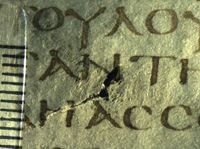 |
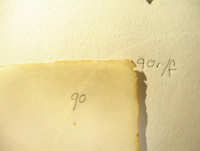 |
| Loss - internal |
Loss - edge |
Weak areas are areas on the leaf that can barely support their own weight and are thus vulnerable to damage by handling.
These areas needed attention before digitization
A puncture is a hole in the parchment with no loss of material. Pricking holes were excluded.
Recorded was the location, direction ('?' or '?') and diameter of the puncture.
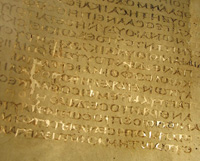 |
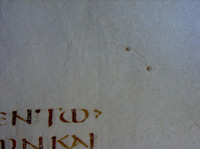 |
| Weak area |
Puncture |
Ink offset is a transfer of ink onto the leaf from ink on another surface. The offset does not necessarily come from a
facing leaf. Excluded are 'squiggles' at the foredge of the leaf, which are consistently the effect of intentional ink offset.
Loss of ink on the parchment can be caused by friability of the ink (i.e. the binding agent of the media is breaking down), flaking (where the
ink is not adhered to the primary support) or fading (loss of colour density). Minor ink loss was defined as
partial loss of ink from characters in a text line and major ink loss was defined as areas having nearly complete
loss of ink.
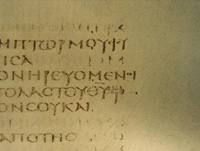 |
 |
| Ink offset |
Ink loss |
Ink corrosion is the deterioration of the ink and the support covered by the ink. The ink composition as well as bad environmental conditions
(e.g. high temperature or high humidity) is the main reasons for this destruction.
Minor ink corrosion was defined as corrosion that has caused pinprick-sized holes which have not locally
weakened the parchment. Major ink corrosion was defined as corrosion that has caused holes larger than a
pin-prick and has locally weakened the parchment area.
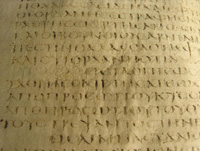 |
 |
| Minor ink corrosion |
Major ink corrosion |
As part of the meticulous physical description of Codex Sinaiticus, the conservation team assessed in detail the condition of past repairs made
on the Codex.
The location of any damaged Cockerell’s parchment repairs was recorded highlighting in particular detaching
repairs or adhesive causing staining and distortions of the parchment.
Cockerell’s silk gauze repairs and linen guards were similarly examined and detaching or causing distortions repairs flagged.
 |
 |
| Condition of parchment repair |
Condition of gauze repair |
The stub guard sewing and stub guard tacketing also could be damaged. The type was identified with a 'W' if the condition was of weakness or
with a ‘B if the thread was broken.
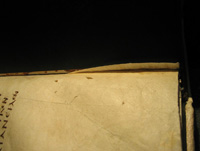 |
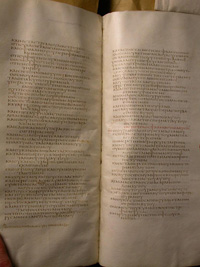 |
| Guard detaching |
Stub guard sewing |
If there was no apparent damage, the condition was described as good ('G').
The condition of the stub guard was also recorded using the same coding.
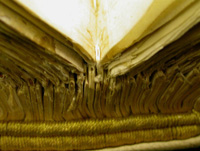 |
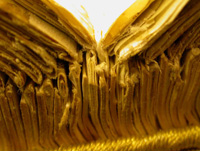 |
| Stub guard tacket stitch |
Stub guard |
Conservation treatment of leaves was strictly limited to what was required to stabilize them for imaging.
The location and type of treatment performed (Japanese paper tissue or Japanese paper fibers or splints) was recorded in this section.